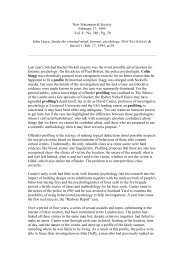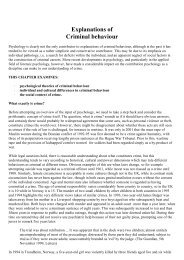Explanations of Criminal behaviour - Jeff Standen
Explanations of Criminal behaviour - Jeff Standen
Explanations of Criminal behaviour - Jeff Standen
Create successful ePaper yourself
Turn your PDF publications into a flip-book with our unique Google optimized e-Paper software.
Mentally ill <strong>of</strong>fenders are not normally held responsible for their crimes unless it can be demonstrated that they<br />
intended to break the law. However, in many trials the distinction between <strong>of</strong>fenders being presented as 'mad' or<br />
'bad' has proved controversial and moved beyond simple psychiatric diagnosis into the realms <strong>of</strong> moral<br />
responsibility. For instance, Peter Sutcliffe murdered 13 women in the 1970s and his defence claimed diminished<br />
responsibility on the grounds that he was suffering from paranoid schizophrenia and heard voices telling him to<br />
kill prostitutes. The jury, however, decided that Sutcliffe was not sufficiently mentally ill to be absolved <strong>of</strong><br />
responsibility for the murders; he was found guilty and sentenced to life imprisonment. Three years later he was<br />
transferred to a special hospital because <strong>of</strong> his mental illness. Similarly <strong>Jeff</strong>rey Dahmer, who murdered and<br />
cannibalised 17 young men in the 1980s, was found not to be suffering from the personality disorder and<br />
necrophilia his defence described, and was sent to prison, where he was murdered by another inmate in 1994. In<br />
both cases there was clear evidence <strong>of</strong> dysfunctional <strong>behaviour</strong> with psychiatric symptoms, and yet the horrific<br />
nature <strong>of</strong> the crimes seems to have demanded some form <strong>of</strong> public accountability and retribution.<br />
Theories <strong>of</strong> criminal <strong>behaviour</strong><br />
. Figure 1.11: Serial killer <strong>Jeff</strong>rey Dahmer makes his initial court appearance in<br />
Milwaukee County Court with his lawyer, 25 July 1991. Dahmer is wearing the<br />
shirt <strong>of</strong> one <strong>of</strong> his 17 victims<br />
Most theories attempting to explain criminal <strong>behaviour</strong> represent part <strong>of</strong> the classic psychological nature versus<br />
nurture debate: can <strong>behaviour</strong> be seen as the result <strong>of</strong> heredity or the effect <strong>of</strong> the environment?; are criminals<br />
born, bad, or are they somehow made bad? Do <strong>of</strong>fenders rationally choose to commit crime, or are they<br />
somehow programmed to do so? Genes are <strong>of</strong>ten said to set the limits on <strong>behaviour</strong>, while the environment<br />
shapes development within those limits. Thus a child born with some potential to <strong>of</strong>fend may, depending upon<br />
their family environment, come to realise that potential or not. The discovery that our genetic make-up may not<br />
be as complex as was once believed suggests that the interaction between genetic vulnerability and environmental<br />
protection has become even more worthy <strong>of</strong> investigation.<br />
Theme link to Perspectives and Issues (the nature-nurture debate)<br />
Plomin (2001) suggests that <strong>behaviour</strong>al genetics must become a prime component within the study <strong>of</strong><br />
psychology in the future, not in the traditional and much criticised sense <strong>of</strong> genetic determinism but<br />
because '<strong>behaviour</strong>al genetic research provides the strongest available evidence for the importance<br />
<strong>of</strong> environmental factors'. (p.134) He adds that most <strong>behaviour</strong>al disorders reveal some genetic<br />
influence, in fact rather more so than common medical disorders, but that the exact nature <strong>of</strong> the<br />
'genotype-environment correlations' will require sensitive and sophisticated analysis. Intervention is then<br />
more likely to involve changes to the environment rather than genetic engineering.<br />
All theories <strong>of</strong> criminal <strong>behaviour</strong> try to address the question <strong>of</strong> why people commit crime on the assumption that<br />
such a course <strong>of</strong> action merits explanation <strong>of</strong> the inexplicable, that criminals are somehow different from the rest<br />
<strong>of</strong> us, and that there might be a single cause <strong>of</strong> criminal <strong>behaviour</strong>. However, one <strong>of</strong> the major reasons <strong>of</strong>fenders<br />
commit crime is simply because they enjoy it. Katz (1988) has spoken <strong>of</strong> the 'seductions <strong>of</strong> crime', while Hodge,<br />
McMurran and Hollin (1997) refer to criminal <strong>behaviour</strong> as an 'addiction'. Both perspectives recognise that the<br />
'buzz' <strong>of</strong> risk, danger, fun, opportunism, status, and finanical gain merit serious examination. Joy-riding is a good







